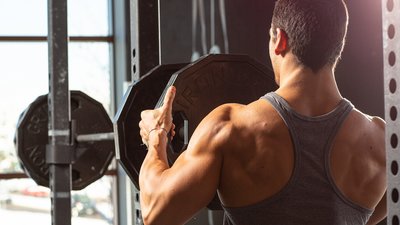Growing up, my favorite wrestler was Lex Luger, also known as "The Total Package." This guy was absolutely off the meat rack, and two components of his physique that really stood out were his chest and shoulders.
I don't know any lifter who doesn't want a bigger, fuller chest and shoulders. I already wrote an article titled "Pec Blastin' 101." Now I'm here to help you build the type of big, full shoulders that cap off any well-balanced physique.
You may not want to look exactly like Lex, but you could probably put better deltoids to good use. Heck, they look as good under a suit as they do in the gym. The information below will help you get there in the safest and most effective manner possible.
The Scapula's Connected To The ...
I'm assuming you're seated while reading this. If not, sit up—or sit down—for a second. Round your shoulders forward as far as you can. I want you to create the worst upper body posture you can imagine: shoulders slouched, head forward, the works. Now, try to lift your arms over your head. Take note of how high they can move and how the movement feels. Chances are that your range of motion sucks, and it feels horrible.
Now, sit up straight and tall and repeat the exercise. Feels a bit different, right?
There's a lot more to shoulder movement than the shoulder alone. When things work the way they should, the thoracic spine (upper back), scapulae (shoulder blades) and gleno-humeral joint (shoulders) all work together to create smooth, integrated upper-body movement. Each joint depends on quality motion or movement at the adjacent or preceding joint.
So instead of thinking solely about the shoulder, we need to think of shoulder movement as a three-part system:
- Thoracic Spinr
- Scapulae
- Glenohumeral Joint
This connection works in the negative as well. If your thoracic spine is slouched over, the entire system gets out of whack. The scapulae move out of position, and because the shoulder is slave to the scapulae, your shoulder isn't going to move or feel right. Your ability to lift your arms overhead will become compromised, and you can risk injury by continuing to try.
The lesson here is that it's crucial to keep your shoulders and upper back healthy over the long haul. You don't realize how important this system is until it stops working properly. Next thing you know, you start missing upper-body training sessions, or even worse, that lingering shoulder injury starts affecting your ability to squat.
Shoulder Anatomy—And What It Means To You
Now that we've covered the joints involved, let's look at the muscular anatomy. There are two primary areas of your shoulder anatomy you should know inside and out: the deltoids and the rotator cuff.
The deltoids are the big cannonball-looking muscles on the top of your shoulders. They are typically broken down into three constituent parts. The anterior deltoids are the foremost section of the deltoids. They are largely responsible for lifting the shoulder in front of the body (shoulder flexion). On the backside of the shoulder, the posterior deltoids balance the anterior deltoids and bring the flexed arm back toward the body (shoulder extension). They also factor slightly into external shoulder rotation. In between the two are the middle deltoids. These muscles are responsible for abducting the shoulder past 30 degrees, i.e., lifting it out to the side.
While the deltoids are larger and more aesthetically prominent than the rotator cuff (or "rotary cup," as it's called here in Indiana) these smaller muscles are equally important to keeping your shoulders strong and healthy.
In the rotator cuff, the supraspinatus runs along the top of your scapula and is responsible for the first 30 degrees of abduction of the shoulder. The infraspinatus and teres minor run along the backside of your shoulder blade and are responsible for external rotation of the shoulder. Last but not least, the subscapularis runs along the inside of your shoulder blade (adjacent to the rib cage), and is responsible for internal rotation at the shoulder.
More important than their isolated function is how these muscles work in concert. When you lift your arm overhead in any direction, the lifting is largely performed by the deltoids. Simultaneously, the rotator cuff works to pull your humerus back into the socket, putting it in position so those big deltoids can do their job. The deltoids are the big "movers" at the shoulder, while the rotator cuff muscles are the "stabilizers."
In my opinion we spend far too much time on isolated rotator cuff and shoulder exercises, when we need to spend more time integrating function between the two.
The Ultimate Balanced Shoulder Workout
Many lifters are imbalanced front to back. We spend time developing the pecs and anterior delts—especially via the bench press—with nowhere near the same amount of time spent on the backside. As a result, I often recommend isolated posterior delt work.
Here are the big staples you need if you want to build ginormous, healthy shoulders:
- A big-bang compound shoulder exercise
- An isolated posterior delt exercise
- A reflexive rotator cuff exercise
- An exercise that ties together the rotator cuff and scapulae
Of course, we all go to different gyms and that have different pieces of equipment available. Along those same lines, sometimes we have injuries or issues that preclude us from following a program specifically as outlined.
If that explains your situation, try the alternative exercises and achieve the same great effect.

